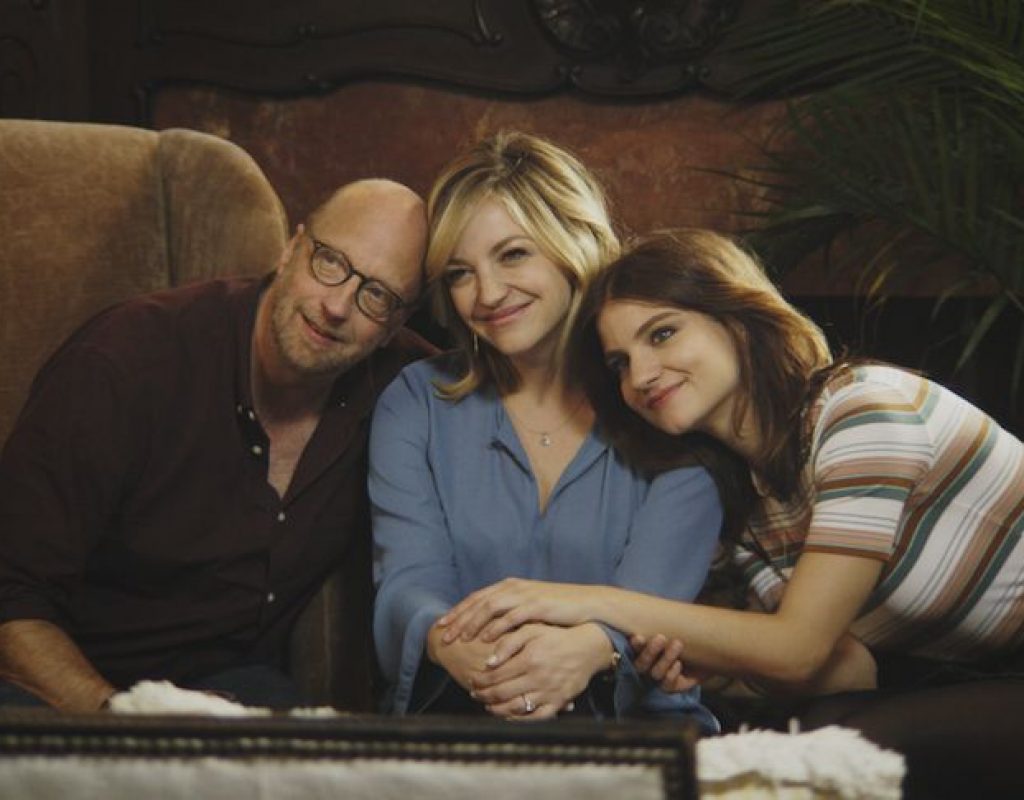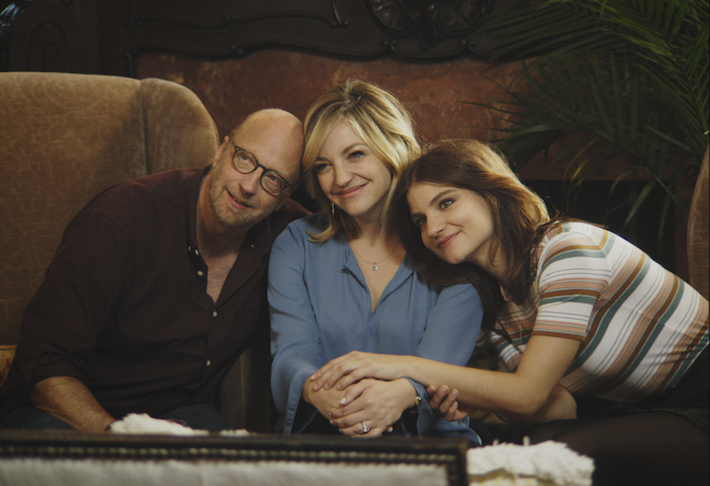 The film Clara’s Ghost premiered recently as part of the 2018 Sundance Film Festival NEXT program. Written and directed by Sundance alum Bridey Elliott, the film stars Bridey and her real-life family of experienced performers. Chris Elliott, Paula Niedert Elliott, and Abby Elliott all feature in a story about a family of former performers. The film was edited by Patrick Lawrence, and I had a chance to catch up with him at Sundance to discuss post-production on this unique project.
The film Clara’s Ghost premiered recently as part of the 2018 Sundance Film Festival NEXT program. Written and directed by Sundance alum Bridey Elliott, the film stars Bridey and her real-life family of experienced performers. Chris Elliott, Paula Niedert Elliott, and Abby Elliott all feature in a story about a family of former performers. The film was edited by Patrick Lawrence, and I had a chance to catch up with him at Sundance to discuss post-production on this unique project.
PVC: So I’m trying to wrap my head around the pitch for this film. It’s layers on layers on layers. Help me out.
Lawrence: Clara’s Ghost is a mix of comedy, family drama and spooky horror film. It’s set in Old Lime, Connecticut, and it’s based around this acting family called the Reynolds family, which is played by the Elliott family. If you’re familiar, the Elliott family are Chris Elliot, who goes way back in people’s minds and you’ve seen him in Groundhog Day, There’s Something About Mary, Letterman, Saturday Night Live, and then his two daughters; Abby Elliott, who was also on Saturday Night Live, and Bridey Elliott, who is the writer/director of this film. The star of the movie is Chris’s wife, Bridey’s mother, Paula Niedert Elliott, and this is her first acting experience. The film is loosely inspired by their real life. Bridey has written this story where the Reynolds are caricatures of the Elliott family, cut down to their core and then emphasized.
So, Clara, who’s the main character, she’s kind of the fifth wheel in the family. She’s not an actor, is constantly separate from their lives because Ted is a famous actor, he’s been around for a while, he’s well known. The two daughters, Julie and Riley, were child stars in the vein of the Olsen twins, and they’re called the Sweet Sisters. So, all of them have their own success in their own right, but Clara’s just kind of been along for all of that. The setting of the movie takes place on their dog’s birthday, which the family is all getting together to celebrate.
PVC: That’s a lot to unpack…
Lawrence: Yeah, and so in the midst of it, it turns into this big drunken mess in the vein of Who’s Afraid of Virginia Woolf, and Clara opens herself up to being possessed by the ghost of the house. And all of this, not only the Elliott family, but also the ghost, the house, are based on real things in Bridey’s life. They say “write what you know,” and she’s definitely written this story based around real life experiences. So, we shot the film in the Elliott home, in Old Lime, Connecticut, and that house was built by an old sea captain. He built it for his daughter, and she eventually went crazy and the town had her committed, and the house was basically in limbo for years. At one point it was a museum. It was the Old Lime Nut Museum, where a lady basically opened up her doors to people coming in and seeing different types of nuts from around the world.
PVC: I have to ask, do we know if there are any other nut museums in the world?
Lawrence: I don’t know, but this is so farfetched, we had to look it up on YouTube, and sure enough, we found a video of the house and this old lady singing a song about her nut museum.
PVC: That sounds like a parody.
Lawrence: Yeah, so the house just basically went through owners before it ended up in the Elliott hands, but as I was editing the film, I had my own room in the house, and I constantly felt like somebody was standing behind me. I would turn around and nobody was there, so I had to ask Bridey. I her if there was something here, and she’s like “oh yeah, oh yeah, for sure.” I felt that. It’s not benevolent in any sort of way, but it’s here.
PVC: I presume what you felt was the ghost of the daughter of the sea captain?
Lawrence: Yeah, possibly. In the film, her name is Adelia, but she is based off of a real thing. She’s based off of a real sea captain’s daughter who went crazy and walked naked through the town, and the town had her committed, and the sea captain was so distraught about it, he ended up killing himself.
PVC: Wild. Ok, so when did you get involved in the project?
Lawrence: I first worked with Bridey two years on her short film “Affections.” That was was her directorial debut, and it ended up going to the 2016 Sundance Film Festival. So, we had already established a working relationship together. I was real early in the talks, and I remember hearing whispers of Bridey writing this movie where like her family is all in it and the mom gets haunted by a ghost…and I was like “well that sounds weird but okay,” and so we started talking seriously about doing this around December 2015. Bridey was putting together a Kickstarter campaign, and I helped put together the pitch video. The pitch was brilliantly shaped in this way where it was like Bridey with a handheld DV camera filming her family sitting on the couch like “hey guys, I’m making a movie, do you want to be in it?” kind of thing, and Chris looks so annoyed. He’s like “oh yeah, whatever, I’m not giving money, I don’t have money to give to your campaign.” In this way, it was like a microcosm of what the film was going to be. We made the film with a big production crew, but it was essentially Bridey making a movie about her family. And Chris I’ve known since I was a kid. I watched him when he was on Get a Life, and Groundhog Day, obviously. Abby I was a little familiar with from Saturday Night Live, and Paula hasn’t really acted before, but she had some stints on Letterman.
That video that we did, the Kickstarter video, really helped me understand who the Elliotts were. So when I finally got the script for Clara’s Ghost and read it, I read all of the characters of the Reynolds in their voices. It really sold the film to me, because it was like the characters were leaping off the page. From then on, I’ve been involved loosely for about two years.
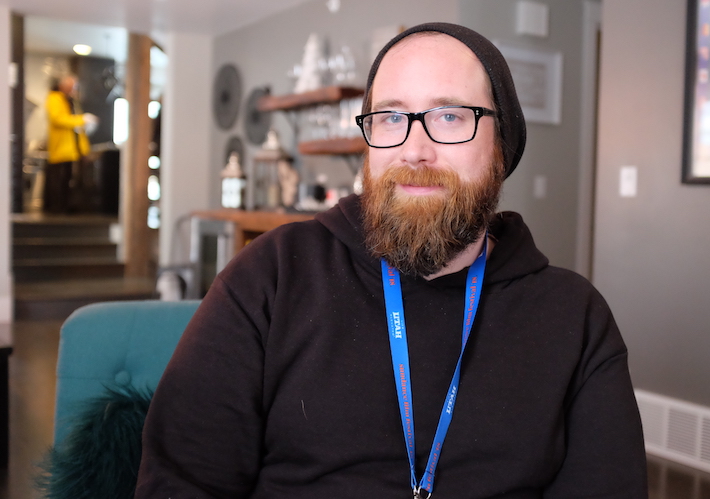 Patrick Lawrence at the Adobe House, Sundance 2018
Patrick Lawrence at the Adobe House, Sundance 2018
PVC: Were you editing onsite throughout production?
Lawrence: Yeah. Originally, the film was going to be shot last Spring, but because of funding, they shifted it to September. The weather had to be a certain way in Connecticut. We knew that we wanted to submit to Sundance, so it was going to be a real quick turnaround. Luckily for me, when I read the script, it’s very conversational, very dialogue-heavy, and that’s easy. There’s no super special effects or action scenes. I knew that I could keep a certain pace, and as an editor, this is my ninth feature film that I’ve done. Probably on four of them, I’ve edited on set.
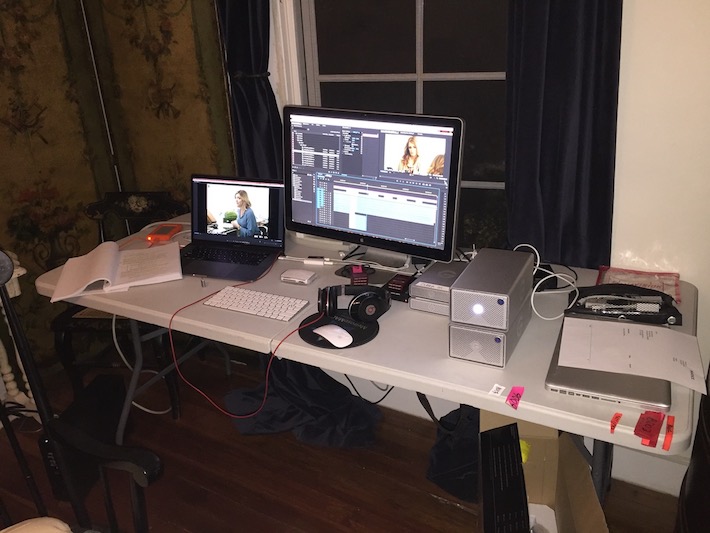
PVC: Do you find that editing on set helps in certain ways, like knowing to ask for things that you couldn’t have got, or having immediate feedback for the director? What’s the advantage for you being there?
Lawrence: Yeah, absolutely. I become more a part of the production itself. I know there are a lot of editors that they have, on bigger budget stuff, they might work remotely from California, or wherever, and they can basically look at dailies and say hey, we don’t have this angle or whatever. I’m able to do that on set. The blessing on Clara’s Ghost is that we shot at the Elliott home for two and a half weeks, so if something was missed or we didn’t have an angle that we needed, I could basically go to the AD, I could go to Bridey and I could say “I think we need a shot of Joe walking up the steps, because we don’t have it. And everybody I worked with on this movie, we had a great working relationship. Markus Mentzer, who was the DP on Clara’s Ghost, we basically got together every night, we looked through shot lists, we looked at the scripts, and I would look at his shot list and suggest shots we might need.
PVC: You’re pre-editing.
Lawrence: Yeah, exactly. We would talk about where things might have been missed or overlooked, and why they’re important to the story. That really helped, because we would go into the next day with a list to give to the AD of shots we needed. Because when you’re shooting like 15 days, a lot gets missed. Especially on low budget Indie projects, and it’s moving fast. I’ve done a couple of other films where sometimes I don’t see footage in time. If I get footage at the end of the day, then I don’t view those dailies until the next day, and we’re already on to another location. And I’m doing a lot. I’m doing DIT, assistant editing, and editing at the same time. Now, if the budget was different, I would be able to have different people doing different things.
PVC: What does that workflow look like?
Lawrence: I get the footage and I ingest it using Shotput Pro. Once it’s ingested, I transcode it using Davinci Resolve so I can begin editing. I just did ProRes LT, I think, on this film.
PVC: Are you doing a one-light, or are you just transcoding it?
Lawrence: On this film, a lot of the color was tweaked in camera. But occasionally when I’m doing that process on other projects, I will talk with the DP and try to get a basic LUT to apply. Because a lot of times, when you’re dealing with producers and clients, they want to see the footage closer to what it will be after the color grade.
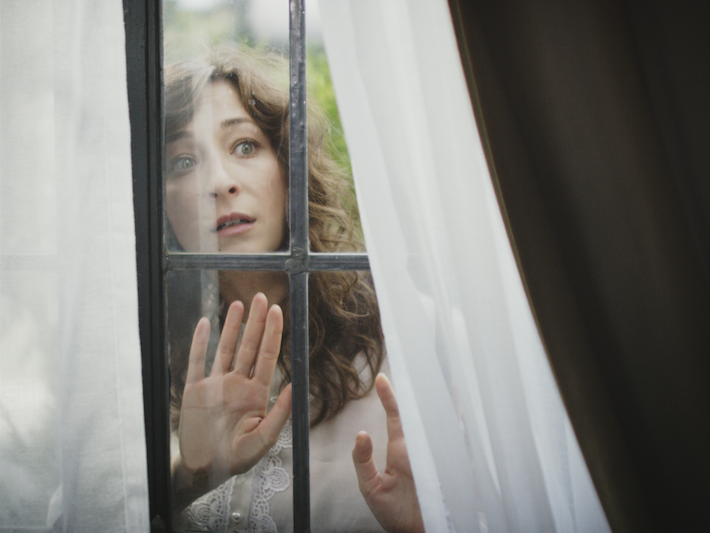
PVC: What did they shoot this film on, and how did the footage come to you?
Lawrence: These were shot on Red Epic Dragons.
PVC: Okay, so you take the R3Ds, you ingest them into your computer, you push them through Resolve, and output ProRes LT files for an offline edit workflow.
Lawrence: Yeah. The film was shot in 6K, so that was heavy on the system. So I transcoded it down to 1080p for the edit. But having 6K was great, because we were able to punch in. There’s a scene in the movie where Clara’s going through this town scrapbook of all the history they’ve kept on the house, and so those shots, you’re looking at it, and you can only get so much detail from it. I was able to really push in on some of the words so you see “woman walks naked through town,” and stuff like that, so that was really nice having it in 6K. Also, I should mention that the film is in 4:3.
PVC: What drove the decision to go with that particular aspect ratio?
Lawrence: That has to do with Bridey’s aesthetic. She’s a huge fan of 70s films. She wanted to have this kind of vintage aesthetic to it. The movie has heavy grain, which, I think it was 2000 ISO.
PVC: They shot a Dragon at 2000 ISO on purpose?
Lawrence: Yeah, it had some grain from the camera. I think there was a little more grain added in the coloring process, but I personally didn’t handle that. From day one when brought the footage in, it looked vintage. It looked like it was almost on film. But I definitely wanted it shot 16:9 for 4:3 because I didn’t want to be held down to anything in terms of shifting frames or punching in. So there is a version of the movie that is mostly 16:9. I had a 4:3 matte that I threw over it, so I could constantly shift and blow things up.
The 4:3 thing all has to do with Bridey’s aesthetic. She’s a big fan of older cinema, she’s definitely a cinefile. When you go to see the film, you don’t expect it to just be this kind of normal, everyday narrative, and I think that’s why we’re part of the Sundance Next program here because it’s just so different. It’s not what you’d expect. And Bridey makes a big point of faces in the film. She loves seeing faces framed up in that way, so having 4:3 gives you real tight frame.
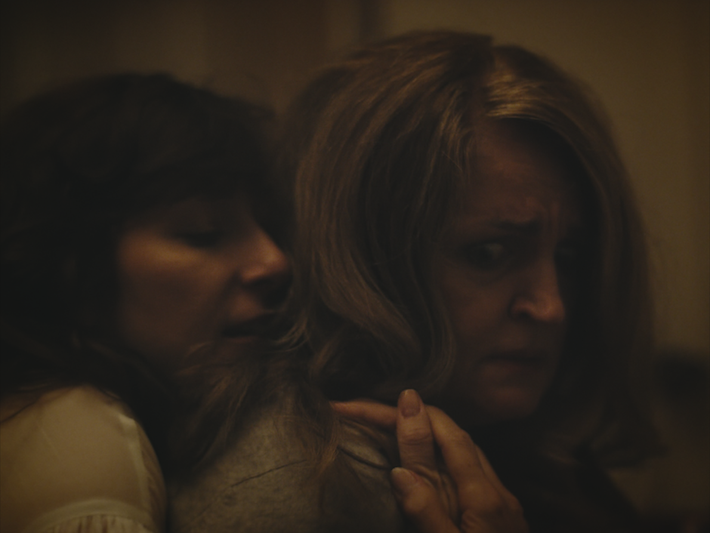
PVC: What is your workflow in Premiere Pro like when you start a film like this?
Lawrence: So I get two footage dumps per day; lunch and at the end of the day. And whatever I get at the end of the day usually starts at the beginning of the next day. I just tackle those dumps one at a time. Hopefully everything is synced, the time code is synced, that makes my transcoding process a little easier. Once it’s synced and transcoded, then I bring it into Premiere Pro. I string everything out in a scene, and then I make markers so I know where each different angle is. I can go through and I can see the top of each angle, and I become kind of familiar with what I’m working with, and then I can visualize the scene in my mind.
Usually, I start with just an establishing wide to see how it plays out. Then, I just start building on top of there, so I know I need to be tight here, I need to be over the shoulder here, this is an insert in the shot. I use the script as a blueprint, but whatever curve ball happened on set, I have to look at that and realize, okay, this is not … throw this out the window. As long as the dialogue is the same, I know I’m working with that. I tackle each scene at a time, and so I really rough cut everything and I try to get it to where this is good, I’m happy with it. If I revisit this in two weeks, it’s still going to be okay.
PVC: So, you’re actually trimming, you’re actually tightening things up.
Lawrence: I’m making audio adjustments, everything. Because especially in an accelerated workflow like this, I need to know that I can go back on a scene and feel good about it.
PVC: So as you edit, each scene is a separate timeline? Do you then nest the scenes, or are you copying and pasting into a master timeline ?
Lawrence: On a feature, I group the scenes together by like 1-10, 11-20, and I just start kind of filling in these bins that I know that when I put together an assembly cut, I can just start copying those files, burning them into one big master timeline.
PVC: So you don’t actually drag that scene sequence into another sequence. You go into that sequence, copy the stuff that you want, and drop it into a master sequence?
Lawrence: Exactly. Yeah, and so I just string it all out, and if my scenes are in a rough cut form the way I like them, then I know that this isn’t going to be far off. I can essentially show this to a director and say “hey, just so you know, this scene is a little rough, but the rest of this is really good.” With Clara’s Ghost, being on set, it was nice because Bridey could come in and see what I was working with, so she was confident that we were getting the right stuff. We have some very complex scenes in this movie. There’s a very frenetic scene where the family’s doing an ice-dunking challenge where they’re putting their face in the ice bowl, and it’s just a drunken mess. But the way that was shot was handheld, and really just no lines of establishment. It was just the cameras all over the room, so it just feels like craziness. It feels like a drunken mess.
And then we have a few kind of musical moments where the family’s getting drunk and sloppy and singing this song and dancing in their ballroom, and those are scenes where we had to know they were working. We have another scene where Clara is dancing by herself to the song Georgie Girl, and it’s supposed to be in her head, but the song’s playing, so for a few minutes, the audience thinks we’re just sitting here listening to the song, but then it cuts out and she’s sitting there dancing and singing it to herself because it’s all in her head. I cut that like a music video. So when you’re dealing with wondering if this is going to sell that it’s playing in her head, and I’m able to sit there and cut that scene together and then show it to them the next day and say “yeah, we got it. This isn’t a problem.”

PVC: After you get your cut, what was the online process like, and who did the grade and finishing?
Lawrence: The color grade was Kyle Kropinski, who is a good friend of mine. He is also a DP and he has shot two of my three short films and almost all of the music videos that I’ve directed. We have a great working relationship, and he also colored Affections, which was Bridey’s short film. He was definitely part of the process early on, and he and I have a smooth workflow that we’ve developed. We have an Avid workflow, and we have a Premiere Pro workflow, so turning things over to him is very easy. I just basically kick out an XML. I don’t do any onlining myself. I just have my reels, and I kick out an XML and he brings it into Davinci Resolve. I also send him a reference with time code, and then he onlines everything himself, and we sit there and we double check every shot. It’s a very simple process, and we’ve done it so many times that it’s painless.
It’s always a pleasure to work with somebody like Kyle, where it’s just so easy to send something out and not worry. Because I’m a narrative mind, I’m a storytelling editor, you know? I don’t have the technical brain for it, which is why I don’t work a lot as an assistant editor. And when the budget doesn’t allow for an assistant editor, I have to know how to do some of these things myself. So it’s very easy for me to just kick out these exports, which Premiere Pro allows you to do pretty seamlessly. The colorist can just bring it in, and everything comes online. It’s amazing.
You can find more information about Clara’s Ghost at www.smudge-films.com/claras-ghost/

Filmtools
Filmmakers go-to destination for pre-production, production & post production equipment!
Shop Now